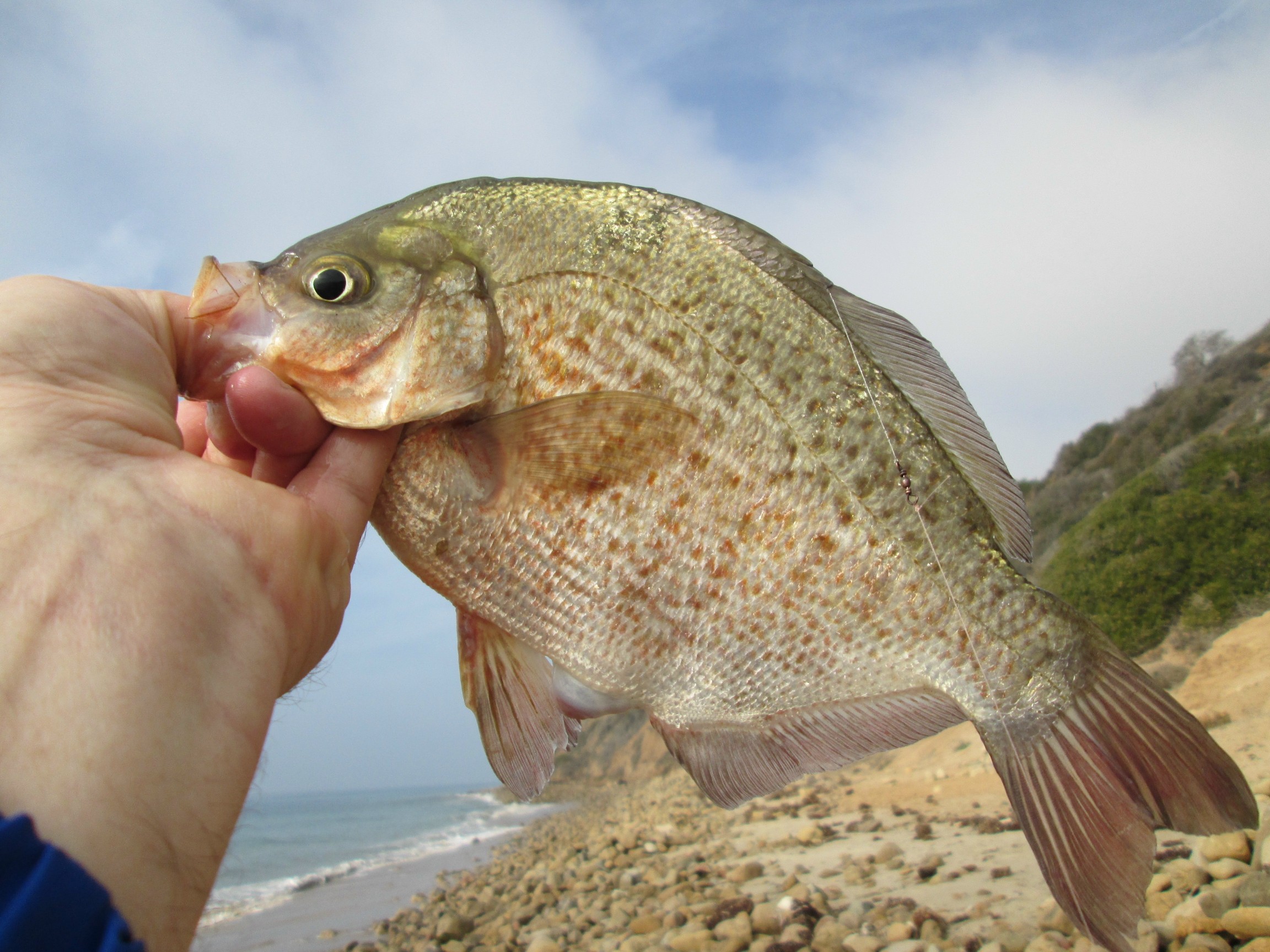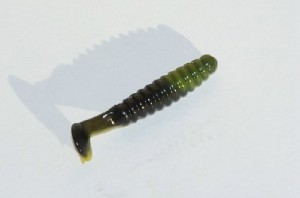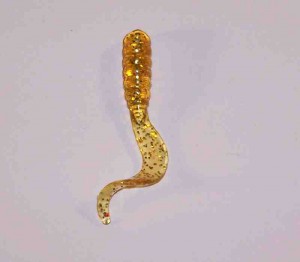Surf Fishing with Grubs
By Bill Varney, Jr.
As the warm water of fall begins to cool sand crabs go into hibernation. Meanwhile, surf fish continue to scour the surf for any forage to carry them though the year. Because food becomes scarce in the winter months fish are always looking for an opportunity to find something good to eat.
That’s why so many artificial lures work well during the winter. Native baits are scarcer during this time but fish still need to eat. So an enticing meal swimming by may get a bite. One of my favorite lures to use for a variety of surfperch in the winter months are surf grubs. Although they work year-round, they seem especially effective during cold-water months.
Plastic grubs come in two distinct shapes: Curley tail and swim tail varieties. I like to use both shapes in the surf. The curly tail imitates a small baitfish while the swim tail adds a thumping vibration to the presentation. One and one-half to three inch grubs seem to work best in the surf.
Use different grub colors depending on the color of the water you are fishing. With waves crashing and churned turbidity, most surf fishing areas have cloudy water. Fish cannot easily see whites and muted colors. Dark colors, which cast a more enticing shadow, match surrounding bait and work best. Motor oil, red flake, gray flake, brown and orange seem to work well.
Tip: The most productive grub colors are: Smoke with glitter, motor oil glitter, watermelon/chartreuse, pearl green/silver glitter, sour grape/purple, caterpillar/yellow and green, avocado, green pumpkin, green/pearl and pumpkin with black flake in both curly tail and swim tail varieties (and all colors which mimic the color of bait that naturally occurs in the local environment)
For the best chance of catching fish always be sure to use colors that resemble the colors of food that occur naturally in the area you are fishing. This is true for all lures used in the surf. Take a look at the bait you find at the beach. Mussel and clams have a brown and orange colored meat, sand crabs are gray and sidewinders crabs are motor oil green and brown. These are the colors you should use as they best imitate the colors of forage living near and on shore.
Some of my favorite grubs are manufactured by Kalin and Slider grub companies. Be sure to pick up a variety of colors and fell free to try several out once you reach the beach to find out what fish are eating that day.
The best way to present grubs to hungry fish is on the Carolina Rig. This is a simple rig and is made up of a sliding egg sinker, a 6mm bead, a swivel, leader material and a very sharp hook.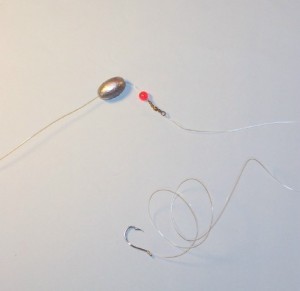
Your sinker size will depend on how much current or wave action you have at the beach. On days when the surf is four feet or larger I use a heavier sinker of up to one ounce. On days with smaller surf I prefer to use a one-half or three-quarter ounce sinker. Remember, it is very important to keep your bait on the bottom, as this is where fish feed, so having a bit heaver sinker is much better than too light.
Beads used between the sinker and swivel help to control the amount of sand which may build up inside the sinker. I like to use a 6mm red or orange bead in the winter and a clear bead in the summer. When fishing for summer corbina it is important to hide your rig as well as possible. Whereas, during winter the colorful bead helps to attract perch and other fish.
Your swivel and leader would be next. I use a number twelve black swivel and six pound fluorocarbon leader material. Black reflects little light and looks natural in the sand while fluorocarbon is invisible (or so they say!) and is very abrasion resistant.
At the end of my leader is a sharp hook. Sharp hooks may be the most important part of your rig. See, I said the words “sharp hook” twice because it’s so important!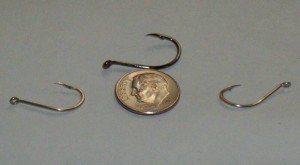 There are several good hooks available on the market but my favorite are black, size two or four, Gamakatsu split shot/drop hooks, Owner mosquito hooks or Mustad ultra point hooks. All three are thin wire hooks that are very sharp and work perfectly with grubs.
There are several good hooks available on the market but my favorite are black, size two or four, Gamakatsu split shot/drop hooks, Owner mosquito hooks or Mustad ultra point hooks. All three are thin wire hooks that are very sharp and work perfectly with grubs.
Now that you have the rig set up it’s time to hook the grub. Grubs must be placed on the hook so they lay as flat as possible. Any small turn in the grub will cause it to spin and not appear natural.
The first step in hooking a grub is to place the hook against the bait to see where the hook’s end will punch through the grub body. Next, check the grub to see if it has lines, like a seam, left by the mold. If so, be sure to center your hook between those lines.
Holding the grub between thumb and forefinger insert the hook into the center of the head and pull the hook toward the tail making sure to keep it centered in the grub. Once the hook is far enough down so the eye of the hook is now at the head of the grub exit with the hook’s sharp end. Now that the hook’s shaft is buried in the grub stop and pull the grub back toward the eye. This will even-out the grub and help to keep it flat on the hook.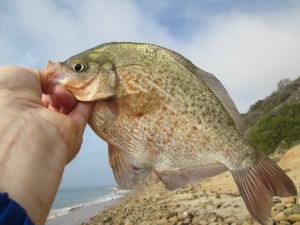
Think about presentation—the more the grub looks like it’s flat and freely moving through the water (without a hook) the better chance you’ll get a bite. Take a moment to pull the grub just underwater in front of you and make sure it swims freely and doesn’t spin. Now you are ready to cast out.
Now that you know how to rig a grub the next step is finding the best way to present this bait to surf fish. Using the grub allows you to cover the greatest area and search for fish. Begin by fan casting—that is, casting to the left side, straight out and to the right. Try to cover as much area as possible. If you don’t get bites after ten minutes move down the beach and try again until you find the fish.
Let your bait sink to the bottom and slowly retrieve it back. The colder the water the slower your retrieve should be. When the waves are pulling back, wait a moment during the retrieve and let your bait rest—you can expect bites here as fish are pulled by the current past your bait. Always keep your line tight to your sinker and your bait on the bottom.
Lastly, comes the dippin’. I place about two ounces of fish attractant in a small snack size zip bag. My favorite fish attractant without question? Taco shop hot sauce! I use two packets (can’t tell if I like Taco Bell® or Del Taco® the best). Just dip your grub (or really any bait) into the sauce and cast it out. Every few casts take a moment to reapply. You’ll be amazed by how many more fish you catch with this simple addition. Please believe me—it really works!
Halibut, barred surfperch, yellowfin croaker, walleye surfperch and many other surf fish are attracted to grubs. Although grubs work all year long they seem to work their very best in winter when bait is scarce and fish are hungry.
Tip: All perch like grubs but especially the small fast ones. To catch the biggest surfperch use your grub to find the fish. Once you have a good bite going, switch to a live bait like the sidewinder (lined shore) crab. 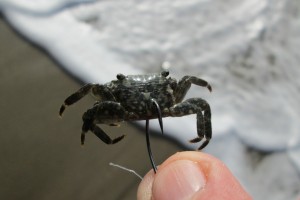 Only the largest perch will bite this bait. How do we know that? Because the last two state record barred surfperch were caught on them!
Only the largest perch will bite this bait. How do we know that? Because the last two state record barred surfperch were caught on them!
